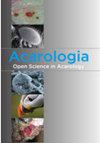在不同温度下以藏螨Thyreophagus sp.(Acari:Acadidae)为食的新食螨(Karg)(Acari:Phytoseidae)的生活史
IF 0.9
3区 农林科学
Q3 ENTOMOLOGY
引用次数: 1
摘要
在20、25和30°C的三个不同温度下,研究了以藏螨Thyreophagus sp.为食的新食螨的发育和生活史参数。结果表明,温度对该捕食性螨的幼螨发育、产卵期及繁殖潜力有显著影响。未成熟的发育时间和成年的预期寿命分别为11.36至6.06天和58.71至38.65天,这取决于温度。在20°C(27.21)、25°C(46.38)和30°C(61.12)条件下,每只雌性的平均产卵总数差异显著。30°C时的最高净繁殖率(R0)为51.95(后代/个体),尽管与25°C时(37.10)没有显著差异。此外,30°C下的最高固有繁殖率(rm)为0.286 day-1。此外,在30°C下还确定了最高的有限增长率(λ=1.031天-1)、最短的平均生成时间(T=13.786天)和加倍时间(DT=2.418天)。我们的研究结果表明,N.agrestis成功地完成了未成熟发育,并且可以在所有测试温度下存活和繁殖。然而,这种食肉动物的许多生物学特征都受到食物来源温度的影响。最后,30°C的温度似乎更适合在Thyreophagus sp.上大规模饲养这种捕食者。应该进行进一步的研究,以确定N.agrestis对各种重要害虫(如蜘蛛螨、粉虱和蓟马)的生物学特征和生命周期参数。本文章由计算机程序翻译,如有差异,请以英文原文为准。
Life history of Neoseiulus agrestis (Karg) (Acari: Phytoseiidae) fed on the storage mite, Thyreophagus sp. (Acari: Acaridae) at different temperatures
The development and life history parameters of Neoseiulus agrestis feeding on the storage mite, Thyreophagus sp., were studied at three different temperatures of 20, 25, and 30 °C. The results show that juvenile development and oviposition period as well as reproductive potential of this predatory mite are significantly affected by the temperature. The development times of immature and the life expectancy of adults ranged from 11.36 to 6.06 days and 58.71 to 38.65 days, respectively, depending on the temperature. The average total number of eggs laid per female at 20 °C (27.21), 25 °C (46.38), and 30 °C (61.12) differed significantly from each other. The highest net reproductive rate (R0) was 51.95 (offspring/individual) at 30 °C, although there was no significant difference from that obtained at 25 °C (37.10). Furthermore, the highest intrinsic rate of increase (rm) is 0.286 day-1 at 30 °C. Moreover, the highest finite rate of increase (λ = 1.331 day-1) and the shortest mean generation time (T = 13.786 days) and doubling time (DT = 2.418 days) were also determined at 30 °C. Our results indicate that N. agrestis successfully completed immature development and can survive and reproduce at all temperatures tested. However, a number of biological traits of this predator are affected by the temperature on this food source. Finally, a temperature of 30 °C seems to be more suitable for mass rearing of this predator on Thyreophagus sp. Further studies should be carried out to determine the biological characteristics and life cycle parameters of N. agrestis on various important pests such as spider mites, whiteflies and thrips.
求助全文
通过发布文献求助,成功后即可免费获取论文全文。
去求助
来源期刊

Acarologia
ENTOMOLOGY-
CiteScore
2.00
自引率
18.20%
发文量
81
期刊介绍:
Acarologia is a free open-access journal. Please help us by submitting manuscripts in accordance with following instructions.
All manuscripts which do not conform to the instructions will be returned to authors without the benefit of review.
Acarologia publishes the results of original research on all aspects of Acarology.
The journal policy is that taxonomic descriptions should include several species within a same genus/family, when possible.
The editors reserve the right to refuse manuscripts when authors intentionally divide individual species descriptions of the same genus/family into distinct publications.
Single species descriptions should be clearly justified based on their scientific interest.
 求助内容:
求助内容: 应助结果提醒方式:
应助结果提醒方式:


